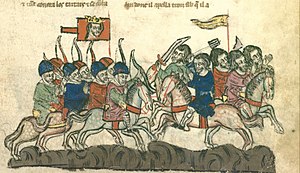
Back الغزوات المغولية على جورجيا Arabic Monqolların Gürcüstanı ələ keçirməsi Azerbaijani Invasions mongoles de Geòrgia Catalan Invasiones mongolas de Georgia Spanish حمله مغول به گرجستان Persian Invasion mongole en Géorgie French הפלישה המונגולית לגאורגיה HE Invazija Mongola na Gruziju Croatian Invasi Georgia oleh Mongol ID モンゴルのグルジア侵攻 Japanese
| Mongol invasions of Georgia | |||||||
|---|---|---|---|---|---|---|---|
| Part of the Mongol conquests | |||||||
 A miniature depicting an attack of the Georgian king George IV Lasha on Mongols in 1220. La Flor des estoires de la terre d'Orient by Hayton of Corycus. King George is shown in blue garment on a white horse holding a whip. | |||||||
| |||||||
| Belligerents | |||||||
| Mongol Empire |
| ||||||
| Commanders and leaders | |||||||
|
Subutai Jebe |
George IV Rusudan | ||||||
The Mongol invasions of Georgia (Georgian: მონღოლთა ლაშქრობები საქართველოში, romanized: mongholta lashkrobebi sakartveloshi), which at that time consisted of Georgia proper, Armenia, and much of the Caucasus, involved multiple invasions and large-scale raids throughout the 13th century. The Mongol Empire first appeared in the Caucasus in 1220 as generals Subutai and Jebe pursued Muhammad II of Khwarezm during the destruction of the Khwarezmian Empire. After a series of raids in which they defeated the combined Georgian and Armenian armies,[1] Subutai and Jebe continued north to invade Kievan Rus'.
A full-scale Mongol conquest of the Caucasus and eastern Anatolia began in 1236, in which the Kingdom of Georgia, the Sultanate of Rum, and the Empire of Trebizond were subjugated, the Armenian Kingdom of Cilicia and other Crusader states voluntarily accepted Mongol vassalage, and the Assassins were eliminated. Mongol rule in the Caucasus lasted until the late 1330s.[2] During that period, King George V the Brilliant restored the kingdom of Georgia for a brief period before it finally disintegrated due to Timur's invasions of Georgia.